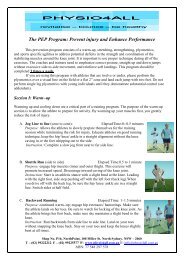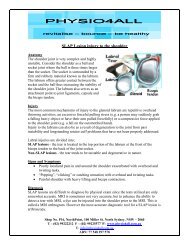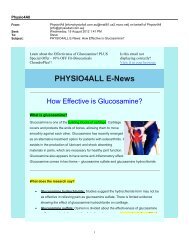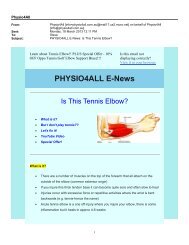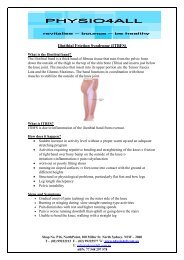Tibialis Posterior Dysfunction - PHYSIO4All
Tibialis Posterior Dysfunction - PHYSIO4All
Tibialis Posterior Dysfunction - PHYSIO4All
You also want an ePaper? Increase the reach of your titles
YUMPU automatically turns print PDFs into web optimized ePapers that Google loves.
PHYSIO4ALL<br />
revitalise – bounce – be healthy<br />
<strong>Tibialis</strong> posterior dysfunction/ Tendonopathy<br />
<strong>Tibialis</strong> posterior dysfunction is an inflammation and/or overstretching of the tibialis<br />
posterior tendon in the foot. An important function of this tendon is to help support the<br />
arch of the foot. However in tibialis posterior dysfunction, the tendon’s ability to perform<br />
that job is impaired, often resulting in a flattening of the foot. The collapse of the arch<br />
can lead to heel pain, arch pain, plantar fasciitis and/or heel spurs. Pain will be more<br />
severe upon weight bearing, especially while walking or running. It can even cause knee,<br />
hip and back pain due to changes in gait.<br />
The tibialis posterior tendon extends from the tibialis posterior muscle in the leg. It<br />
descends the lower leg and runs along the inside of the ankle, down the side of the foot,<br />
and into the arch. This tendon serves as one of the major supporting structures of the foot<br />
and helps the foot to function while walking.<br />
Signs & Symptoms<br />
• Often characterized by inflammation/swelling of the tendon.<br />
• Pain on the inside of the ankle and foot.<br />
• Flattening of the arch of the foot<br />
• Inward rolling of the ankle<br />
• In some severe cases, the inflammation may actually case the tendon to rupture,<br />
causing a very identifiable flat foot. This is very rear.<br />
Shop No. P16, NorthPoint, 100 Miller St. North Sydney. NSW – 2060<br />
T – (02) 99222212 F – (02) 99225577 W: www.physio4all.com.au<br />
E: info@physio4all.com.au<br />
ABN: 77 548 297 578
PHYSIO4ALL<br />
revitalise – bounce – be healthy<br />
Causes & Risk Factors<br />
• Overuse and strain of the tibialis posterior tendon.<br />
• Poor foot mechanics and flat feet may lead to tibialis posterior tendon<br />
dysfunction.<br />
• Stiff first ray (Big Toe)<br />
• Stiff ankle joint<br />
• In its initial stages, inflammation caused by tibialis posterior dysfunction usually<br />
comes and goes rapidly. Over time, though, the condition worsens and the tendon<br />
will degenerate.<br />
Physiotherapy treatment may include<br />
Biomechanical lower limb and foot analysis<br />
Electrotherapy in acute stages<br />
Cryotherapy – ice for 10 mins on a regular basis<br />
Release to tight muscles and soft tissue structures<br />
Acupuncture<br />
Functional and eccentric strengthening program<br />
Taping- to support the arch<br />
Possible orthotics prescription to control poor foot mechanics.<br />
Assessment of lumbar spine and sacroiliac joint to eliminate referred pain<br />
Usually the healing process will take 4-6 weeks to settle<br />
Graded return to weight bearing exercise<br />
In severe cases a Walker/Moon boot may be indicated<br />
In the case of a severe tendinopthy, surgery may be indicated.<br />
Differential Diagnosis<br />
Achilles Tendon injury<br />
Calf Strain<br />
Ankle injury – ligamentous or impingement<br />
Planta Fasciitis<br />
Bruised heel<br />
Nerve entrapment syndrome<br />
Lumbar-Sacral nerve irritation<br />
Shop No. P16, NorthPoint, 100 Miller St. North Sydney. NSW – 2060<br />
T – (02) 99222212 F – (02) 99225577 W: www.physio4all.com.au<br />
E: info@physio4all.com.au<br />
ABN: 77 548 297 578




